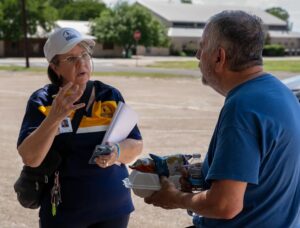
EDITOR’S NOTE: In recognition of the SBC’s October emphasis on the Cooperative Program, Baptist Press will provide readers with extra news and information detailing the scope and depth of the Cooperative Program and its impact for the Kingdom. Using vignettes and profiles of churches and individuals, as well as historical and ongoing accounts, our intent is to explain the Cooperative Program not just as a funding channel but as one of the critical ties that bind Southern Baptists in voluntary fellowship for cooperative ministries and missions.
ALPHARETTA, Ga. (BP)–Several years ago through my oldest son’s soccer league, we met a family of lifelong Southern Baptists who had been actively involved in their church. When their church became embroiled in conflict, this family decided to leave.
Many cities today offer church hunters a wide variety of choices. Sometimes when people have a painful church experience, their next stop is a mega-church. A larger church apparently seems to be a safe place to chill and re-group.
This family was about to make the same decision, but they didn’t realize that the church they were visiting wasn’t Southern Baptist. It looked Baptist, sounded Baptist and featured leadership of former Southern Baptists. But it was not a cooperating Southern Baptist church.
So I asked, “What about the missionaries?”
The question confused them, so I further explained that moving their membership to an independent church would mean they would no longer be supporting more than 11,000 Southern Baptist missionaries as they had much of their lives through the Cooperative Program and annual mission offerings. These friends had what I would call a deer-in-the-headlights look as they had not considered what it meant to attend a non-Southern Baptist church.
More recently, I had a workman in my house. As we talked, I learned that he was raised Methodist, his wife was raised Southern Baptist, and now they sporadically attend a large non-denominational church. He figured it didn’t matter because they all worshipped the same God.
On one level, I can agree with him. Most communities have a host of non-Southern Baptist churches that are biblically sound. Likewise, there are respected para-church ministries that meet real needs.
However, on another level I couldn’t disagree more. It does matter where we worship and how we invest our lives in the fulfillment of the Acts 1:8 mandate. If you only get one life to invest in the propagation of the Gospel, don’t you want to do that as effectively as possible? And is there a better way for a church to accomplish a huge task than to work with more than 44,000 cooperating partners?
That question transcends families looking for a home church. The current debate within our denomination about a Great Commission resurgence reveals that there is less solidarity about the Cooperative Program than many may have assumed. Lifelong Southern Baptists who understood the Cooperative Program’s foundation to be a percentage contribution of their church’s undesignated offerings are learning that this is clearly no longer a given. Nor is the unwritten standard or goal of that percentage being around 10 percent a given. Now we hear people defining the Cooperative Program to include direct missions support plus a percentage designation — usually much less than 10 percent of undesignated gifts. This expanded definition seems to open the door to the competitive and often chaotic societal mission methods that our Southern Baptist forefathers — for good reason — seemingly slammed shut 84 years ago.
Current cries for greater efficiencies with mission gifts should be welcome by every Southern Baptist. Our mission efforts — through the Cooperative Program, the Annie Armstrong Easter Offering for North American Missions, the Lottie Moon Christmas Offering for International Missions, state mission offerings and contributions to associations — are that important.
Southern Baptists adopted the Cooperative Program in 1925 as a plan through which churches could voluntarily combine resources to accomplish objectives bigger than any one church could do. This has included starting hospitals, seminaries, colleges, children’s homes and sending missionaries.
Looking back, it’s not hard to see how the Cooperative Program and the national missions offerings, along with the foundation of age-graded mission education that has been unique to Southern Baptists, was a God-ordained vision that now results in the mobilization of more than 11,000 missionaries around the world.
To what degree are Southern Baptists committed to maintaining and growing this missionary force?
My guess is that families rarely think of this when they are church hunting. The way families switch churches, denominations and even religions today is mind-boggling. Do churched people know why they are what they are? If you are going to be a Methodist, I encourage you to make that choice based on good reason that includes theology, missions and history.
For my wife and me, we’ve found a good reason to be Southern Baptist long before entering vocational ministry. We attend a church that unashamedly proclaims the Gospel as truth. With our regular tithes, we know that our investment literally goes around the world through the Cooperative Program and when combined with the Annie Armstrong Easter Offering and the Lottie Moon Christmas Offering, we know that we’re having a tremendous impact on the mission field. Through the services of the North American Mission Board and the International Mission Board, we’ve been engaged in meaningful mission experiences around the world. We know that we have joined more than 44,000 other Southern Baptist churches and church-type missions in a vision that’s as valid today as it was 84 years ago.
When someone casts a larger vision than the cooperative missions method of Southern Baptists, I’ll join them. For me, that’s how important it is to spend my life wisely invested in the propagation of the Gospel.
I trust the missionaries would agree.
The bigger question is, Do Southern Baptists agree?
–30–
Jim Burton is team leader for mission education at the North American Mission Board.















